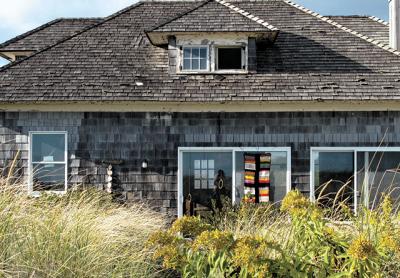Guerrilla Art Installation Protests Teardowns With Textile and Ceramic Works

Exactly one week before Halloween, two artists decided to offer their own trick and treats at a small beachfront cottage in Bridgehampton destined to face the wrecking ball.
On Oct. 24, the artists, both East End residents who wish to remain anonymous, mounted a temporary show of textile and ceramic works at 77 Dune Road. According to an email sent by someone representing the artists, the pieces were made in tribute to the memories they had of growing up in the community during the 1970s and similar cottages that have vanished over the years, replaced by much larger houses.
In place of a long-gone door screen, a sampler of sorts was stitched to a piece of sheer white fabric. It said, “This house has survived 23 hurricanes, 14 nor’easters, two super storms, 22 blizzards. But it will not survive their plans to demolish it. Save this house and keep its gentle footprint.”
A colorful knitted scarf or runner seemed to replicate a series of windowpanes where ospreys, whales, and other indigenous creatures were represented in drawings that were attached to the knitted material. Ceramic vases and trays were embellished with shells.
The theme of the work was “the inherent beauty of a small footprint created in tandem with the natural landscape.” The artists said such Dune Road beach cottages were once plentiful and “were cherished getaways for working middle-class families, as well as the wealthy.” The occupants maintained them with care and minimal decoration. Their attention was focused on the beauty of the “outer environment rather than the house itself.”
According to the property listing, the house was built in 1956 and is 1,200 square feet with two bedrooms. Zoning allows the half-acre lot to accommodate a building of 2,700 square feet, but an architect has already devised plans for a 4,000-square-foot house with a pool and deck. Variances would be needed to realize them.
The artists said the house was maintained until the mid-1990s but has had virtually no occupants since then. The price tag is $8.9 million.
In addition, they said, the dunes in front of the house are home to many indigenous species of plants and wildlife that used to characterize Dune Road, including beach rose, various beach grasses, bayberry, pitch pine, and goldenrod. “On a recent morning, monarch butterflies were seen flying in and out of the dunes,” the email said.
On the day of the guerrilla installation, 40 invited guests viewed the show and then enjoyed a party on the beach near the house.
“We realize what we did was not particularly legal, but it was important to us to honor this beautiful house and spotlight the unsound trend of tearing down these shingle beach houses to build gigantic ones in their place,” the artists said.
Although the show was temporary, they did leave two of the pieces at the house. “We hope that our message will be heard, by realtors and potential buyers, that this house, and the land it sits on, is worth saving.”
